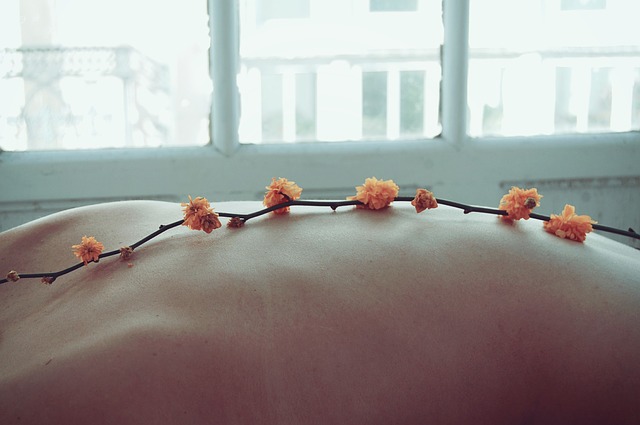Ladies, I invite you to take a moment to tune in to your physical body.
Listen deeply, and explore how your body feels before and during your monthly cycle. What do you notice?
If you’re like many women, you experience a clear set of symptoms each month that indicate that your body is preparing to cleanse and rejuvenate through the monthly process of menstruation. We often hear this set of symptoms referred to as pre-menstrual syndrome (PMS), and most of us are all too familiar with the discomfort this time can present in our lives—from deep back pain to pesky cravings.
But, did you know that we don’t all experience the same PMS symptoms? And are you aware that these symptoms are not necessarily part of a balanced, healthy cycle?
In fact, what you feel before and during your cycle can be quite different from the experiences of other women in your community. This difference is based on your body’s unique constitution and its current state of imbalance in relation to the world around you.
Let me explain.
According to the ancient wisdom of Ayurveda, we are each made up of an individual metabolic constitution that is built from a unique ratio of the three doshas (combination of elements). The three doshas are distinguished as vata, pitta, or kapha, and each give rise to a distinct set of mind-body characteristics. Your body is a brilliant temple in which these elements co-manifest, always responding to your nourishment, environment, and thoughts.
The varying symptoms that manifest during PMS are caused when the unique natural order of the doshas in your body falls out of balance—usually as a result of your dietary choices, activities, or emotional stress levels. By maintaining the subtle balance of the doshas, or elements, in your physical form, you can experience a comfortable, symptom-free period.
The good news is, the discomfort you feel is your body telling you exactly what’s out of balance within, which gives you the tools you need to fix it.
Certain symptoms of PMS are related to a vata-dosha imbalance, others to a pitta-dosha imbalance, and still others to a kapha-dosha imbalance. By paying close attention to the nuances of how you feel in the days leading up to and during your period, you can determine which dosha is out of balance within your body, and work to bring it back into harmony using the tips below.
Identify your PMS type and learn how to avoid its symptoms:
Take a look at the following sections to see which of the sets of symptoms are most closely aligned with your experience in the five or so days leading up to your menstrual cycle. Once you’ve determined the set of symptoms that most closely resembles your experience, find beneath them a few simple changes to your lifestyle that will help you to avoid PMS and menstrual discomfort from now on.
If you experience irregularity, scanty flow, brown blood, constipation, low back pain, insomnia, dizziness, or cravings for salty foods:
These are all signs that your discomfort is caused by an imbalance of vata, which is governed by the elements of ether and air. Some of the qualities of vata include dry, cold, rough, and mobile, so in general, you can treat vata-type PMS by balancing vata with anything that is the opposite quality—things that are slow, warm, smooth, and grounding.
Avoid vata-type PMS symptoms by incorporating these suggestions all month long:
>> Stay warm. In hot months, steer clear of air conditioning and cool pools. In colder months, be sure to bundle up when you go outside.
>> Slow down. Since vata has the ungrounded energy of wind, it’s important to protect yourself from over-stimulation by taking some more time for yourself. Choose to stay in, read, or meditate to calm your system down.
>> Give yourself a weekly soothing, nurturing massage with a warming oil such as sesame.
>> Focus on eating heavier, sweeter foods such as sweet potatoes, squashes, avocados, bananas, coconuts, mangos, dates, brown rice, basmati rice and aduki, and mung beans.
>> Cook warm, moist, and grounding meals such as hearty soups, casseroles, or the Ayurvedic staple food known as kitchari. Note that the qualities of salad are the same as vata, so your daily salad may actually be contributing to your vata-type PMS symptoms.
>> Feature nutmeg, cinnamon, turmeric, dill, and fennel as spices in your cooking.
>> Get very gentle physical exercise through movement such as yoga, tai chi, or walking.
If you experience excess bleeding, bright red blood, irritability, headaches, diarrhea, increased appetite, acne, heartburn, or cravings for sweet or spicy food:
These are all signs that your discomfort is caused by an imbalance of pitta, which is governed by the fire element. Some of the qualities of pitta include hot, sharp, oily, and light, so in general, you can treat pitta-type PMS with anything that is the opposite, including things that are cooling, calming, and grounding.
Avoid pitta-type PMS symptoms by incorporating these suggestions all month long:
>> Stay cool. Do your best to keep your core temperature down. In the summer, drink cucumber water and spritz yourself with rose hydrosol to cool off.
>> Focus on calming activities and give yourself permission to rest.
>> Eat plenty of cooling and/or bitter foods such as leafy greens, artichokes, okra, cucumber, jicama, apricots, berries, pomegranates, melons, barley, aduki, and mung beans. You should also enjoy a bit of dark chocolate!
>> Since the burning fire of pitta can cause intense hunger and cravings, be sure to stabilize your blood sugar by focusing on eating foods with a low glycemic index, including vegetables, legumes, whole grains, nuts, and seeds.
>> Feature cumin, coriander, fennel, saffron, cardamom, and mint as spices in your cooking.
>> Do calming physical exercise, such as swimming, yin yoga, or taking an evening stroll.
>> Spend time in the cooling light of the moon as well as near bodies of water, as these are both very soothing to the fire element of pitta.
If you experience thick flow, bloating, water retention, swollen breasts, depression, teary-eyed emotions, lethargy, or cravings for coffee and salt:
These are all signs that your discomfort is caused by an imbalance of kapha, which is governed by the water and earth elements. Some of the qualities of kapha include cold, slow, heavy, and oily, so in general, you can treat kapha-type PMS with anything that is the opposite, including things that are warming and activating.
Avoid kapha-type PMS symptoms by incorporating these suggestions all month long:
>> Be sure to practice some kind of basic movement every day. A form of movement could include talking a brisk walk or hike, doing a series of yoga poses, or playing with a child.
>> In addition to basic movement, kapha needs the stimulation of more vigorous exercise to keep it in balance. At least twice per week, get some form of high energy exercise like dancing, jogging, or going on a bike ride.
>> To warm and activate your system from the inside, drink eight ounces of warm water with a half teaspoon of cinnamon and a teaspoon of honey every morning.
>> Focus on eating foods that include the pungent (spicy), bitter, and astringent tastes. To include pungent foods in your diet, eat garlic, radishes, and chilies. To include bitter foods in your diet, eat kale and dark chocolate. To include astringent foods in your diet, eat more apples, cranberries, pomegranates, and artichokes.
>> Feature black pepper, mustard seeds, cloves, cinnamon, turmeric, and ginger as spices in your cooking.
>> Avoid foods that cause build up of kapha-toxins (phlegm) in the body. The primary culprits here are gluten and dairy, which, if you tend toward a kapha imbalance, likely don’t make you feel great anyway.
Round out your monthly self-care routine by incorporating these basic practices:
When you combine the following steps, which are great for all constitutions, with your dosha-specific self care above, you’ll be feeling vibrant and activated from the beginning to the end of your cycle.
>> Support your body to digest and eliminate toxins (called ama in Ayurveda) throughout the month so that your body is not overloaded with the task of eliminating toxins during your menstrual time. This allows your body to do its work of clearing and cleansing your uterine lining more effectively. One simple way to detox is to sip warm water with a squeeze of lime frequently throughout the day.
>> Avoid foods that add toxins to your system (thus exacerbating PMS symptoms) such as caffeine, alcohol, excess salt, refined sugar, highly processed foods, frozen or canned foods, or products made from GMOs.
>> Get enough rest on a regular basis. The ideal time to go to sleep is between 9 and 10 p.m., and be sure to spend some time winding down in a calm environment free of electronics for at least 30 minutes beforehand. Aim to get at least seven hours of sleep each night, as the midnight hours are the time in which your body does the most detoxification work.
>> Do your best to align your rhythm with the lunar cycle, aiming to menstruate on the new moon, and ovulate on the full moon. To do so, sleep with a very soft, warm light near your bed during the three days around ovulation, and do a vaginal steam on the day following the new moon.
As a conscious woman, you have the opportunity to tune in to your own unique temple, and to work with the elements within and around you, to implement the simple yet nuanced self-care that works best for you. In doing so, you’ll bring yourself into balance, ensuring you feel light, vibrant, and powerful throughout your entire cycle. You’ll feel your radiance surge, and with it, your creativity, your inspiration, and your ability to make waves in the world.
If you are interested in learning more about using Ayurveda to heal your cycle and connect with your divine feminine essence within, I highly encourage you to read Maya Tiwari’s book, Women’s Power to Heal Through Inner Medicine.
~
Author: Sierra Brashear
Image: Pixabay
Editor: Catherine Monkman
Supervising Editor 1: Danielle Beutell
Supervising Editor 2: Lieselle Davidson
Ready to join?
Hey, thanks so much for reading! Elephant offers 1 article every month for free.
If you want more, grab a subscription for unlimited reads for $5/year (normally, it's $108/year, and the discount ends soon).
And clearly you appreciate mindfulness with a sense of humor and integrity! Why not join the Elephant community, become an Elephriend?
Your investment will help Elephant Journal invest in our editors and writers who promote your values to create the change you want to see in your world!
Already have an account? Log in.
Ready to join?
Hey, thanks so much for reading! Elephant offers 1 article every month for free.
If you want more, grab a subscription for unlimited reads for $5/year (normally, it's $108/year, and the discount ends soon).
And clearly you appreciate mindfulness with a sense of humor and integrity! Why not join the Elephant community, become an Elephriend?
Your investment will help Elephant Journal invest in our editors and writers who promote your values to create the change you want to see in your world!
Already have an account? Log in.
 Share on bsky
Share on bsky



Read 1 comment and reply